Market Research Report: Developing a Culturally Responsive Community
VerifiedAdded on 2023/04/20
|19
|5110
|314
Report
AI Summary
This market research report, conducted by a student, investigates the development of a culturally responsive learning community through collaborative efforts involving faculty, students, and teachers. The report begins with an introduction to the concept of culture in education and its impact on learning environments, highlighting the challenges of accommodating cultural inclusivity in institutions of higher learning. It describes an identified operation focused on understanding cultural identity and the theoretical framework for developing a culturally responsive learning community. The core of the report involves an analysis of various factors influencing student behavior, including family, school, politics, economics, and religion. The research methodology involves a five-day workshop designed to explore these factors through interactive sessions and discussions. The report outlines the research objectives, questions, and methodology used to gather data and presents the outcomes of the research, including the impact of these factors on student behavior and learning. The conclusion offers recommendations for fostering a culturally responsive learning community, emphasizing the importance of understanding diverse perspectives and promoting active learning through faculty professional development and collaboration. The report is based on a workshop conducted at the KDU School of Business and provides valuable insights into creating a more inclusive and effective learning environment.
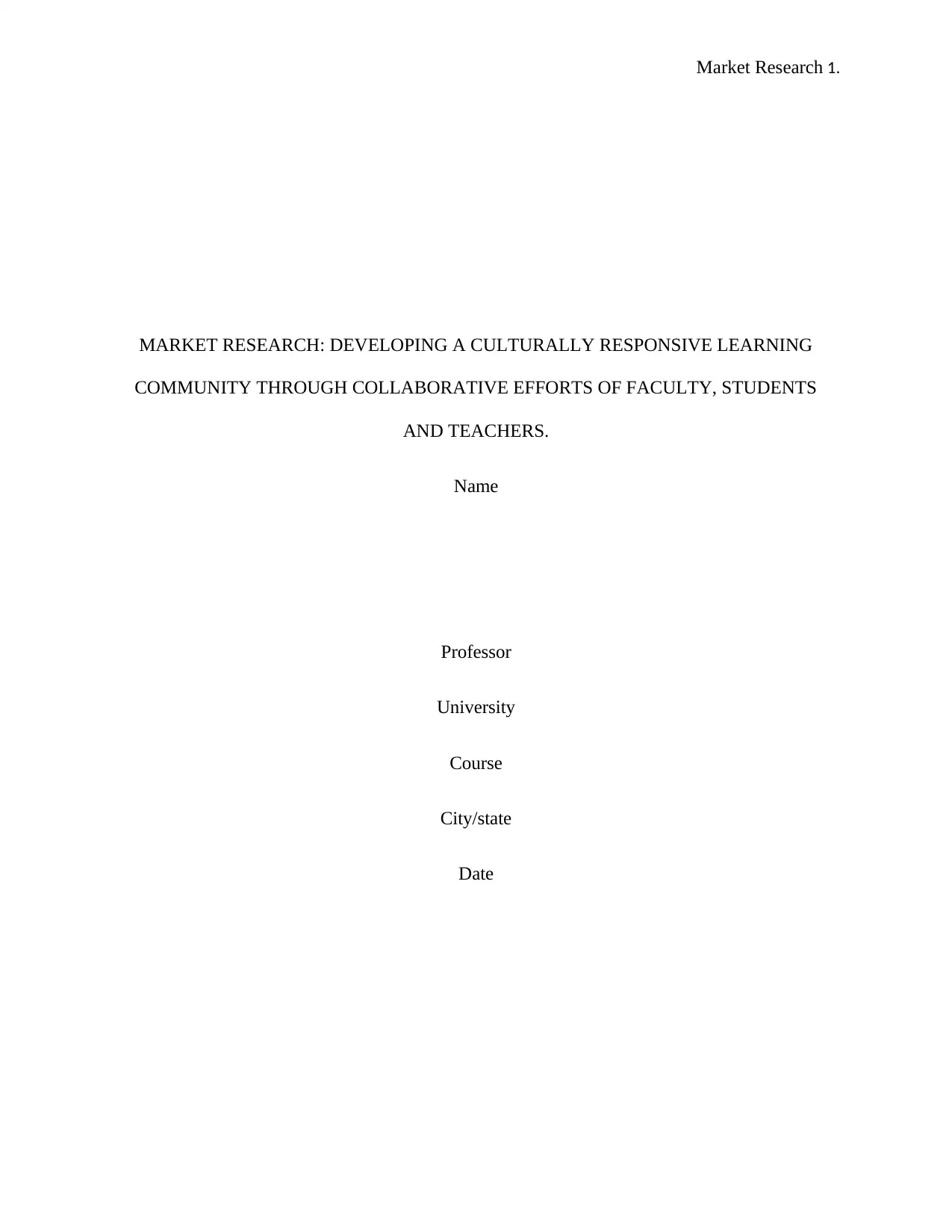
Market Research 1.
MARKET RESEARCH: DEVELOPING A CULTURALLY RESPONSIVE LEARNING
COMMUNITY THROUGH COLLABORATIVE EFFORTS OF FACULTY, STUDENTS
AND TEACHERS.
Name
Professor
University
Course
City/state
Date
MARKET RESEARCH: DEVELOPING A CULTURALLY RESPONSIVE LEARNING
COMMUNITY THROUGH COLLABORATIVE EFFORTS OF FACULTY, STUDENTS
AND TEACHERS.
Name
Professor
University
Course
City/state
Date
Paraphrase This Document
Need a fresh take? Get an instant paraphrase of this document with our AI Paraphraser
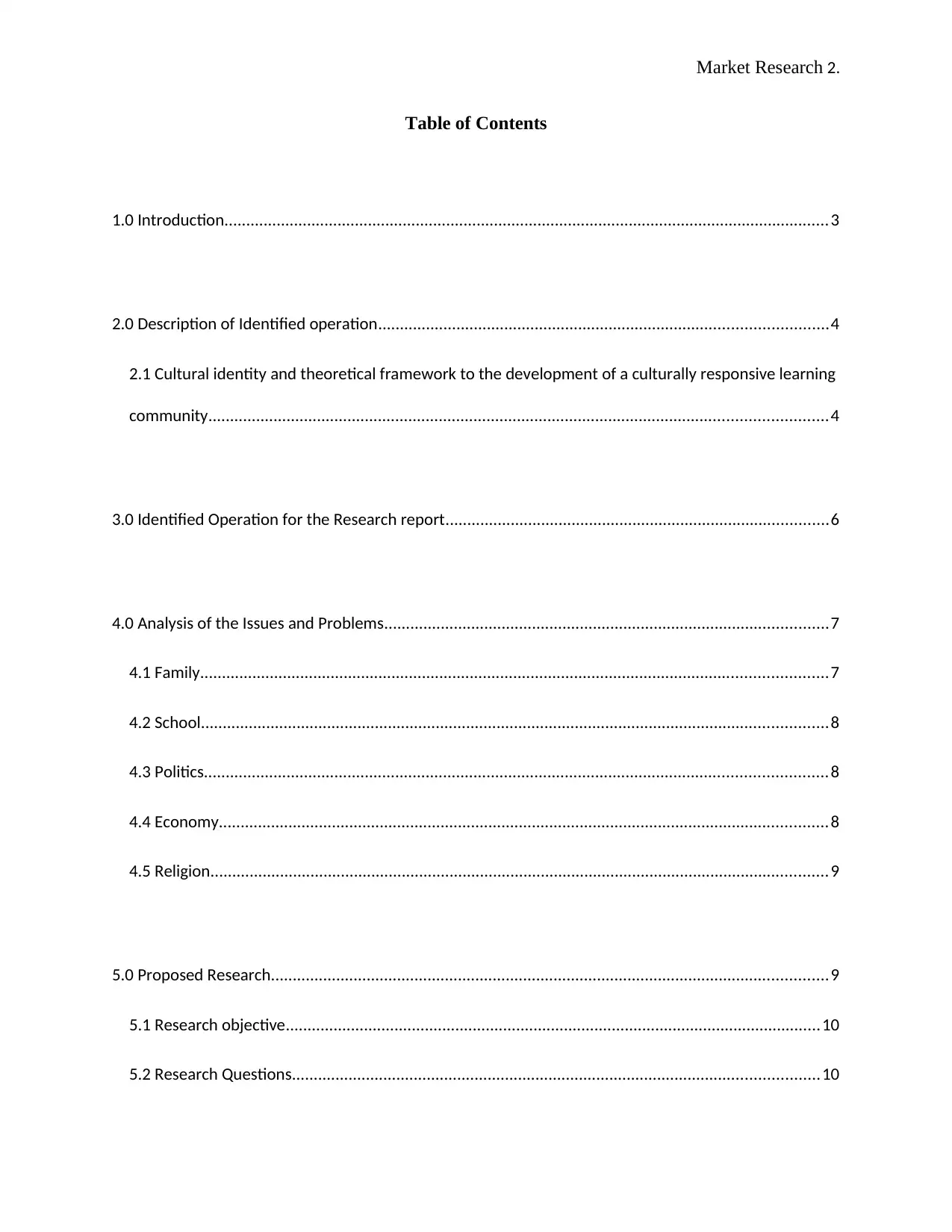
Market Research 2.
Table of Contents
1.0 Introduction...........................................................................................................................................3
2.0 Description of Identified operation.......................................................................................................4
2.1 Cultural identity and theoretical framework to the development of a culturally responsive learning
community..............................................................................................................................................4
3.0 Identified Operation for the Research report........................................................................................6
4.0 Analysis of the Issues and Problems......................................................................................................7
4.1 Family................................................................................................................................................7
4.2 School................................................................................................................................................8
4.3 Politics...............................................................................................................................................8
4.4 Economy............................................................................................................................................8
4.5 Religion..............................................................................................................................................9
5.0 Proposed Research................................................................................................................................9
5.1 Research objective...........................................................................................................................10
5.2 Research Questions.........................................................................................................................10
Table of Contents
1.0 Introduction...........................................................................................................................................3
2.0 Description of Identified operation.......................................................................................................4
2.1 Cultural identity and theoretical framework to the development of a culturally responsive learning
community..............................................................................................................................................4
3.0 Identified Operation for the Research report........................................................................................6
4.0 Analysis of the Issues and Problems......................................................................................................7
4.1 Family................................................................................................................................................7
4.2 School................................................................................................................................................8
4.3 Politics...............................................................................................................................................8
4.4 Economy............................................................................................................................................8
4.5 Religion..............................................................................................................................................9
5.0 Proposed Research................................................................................................................................9
5.1 Research objective...........................................................................................................................10
5.2 Research Questions.........................................................................................................................10
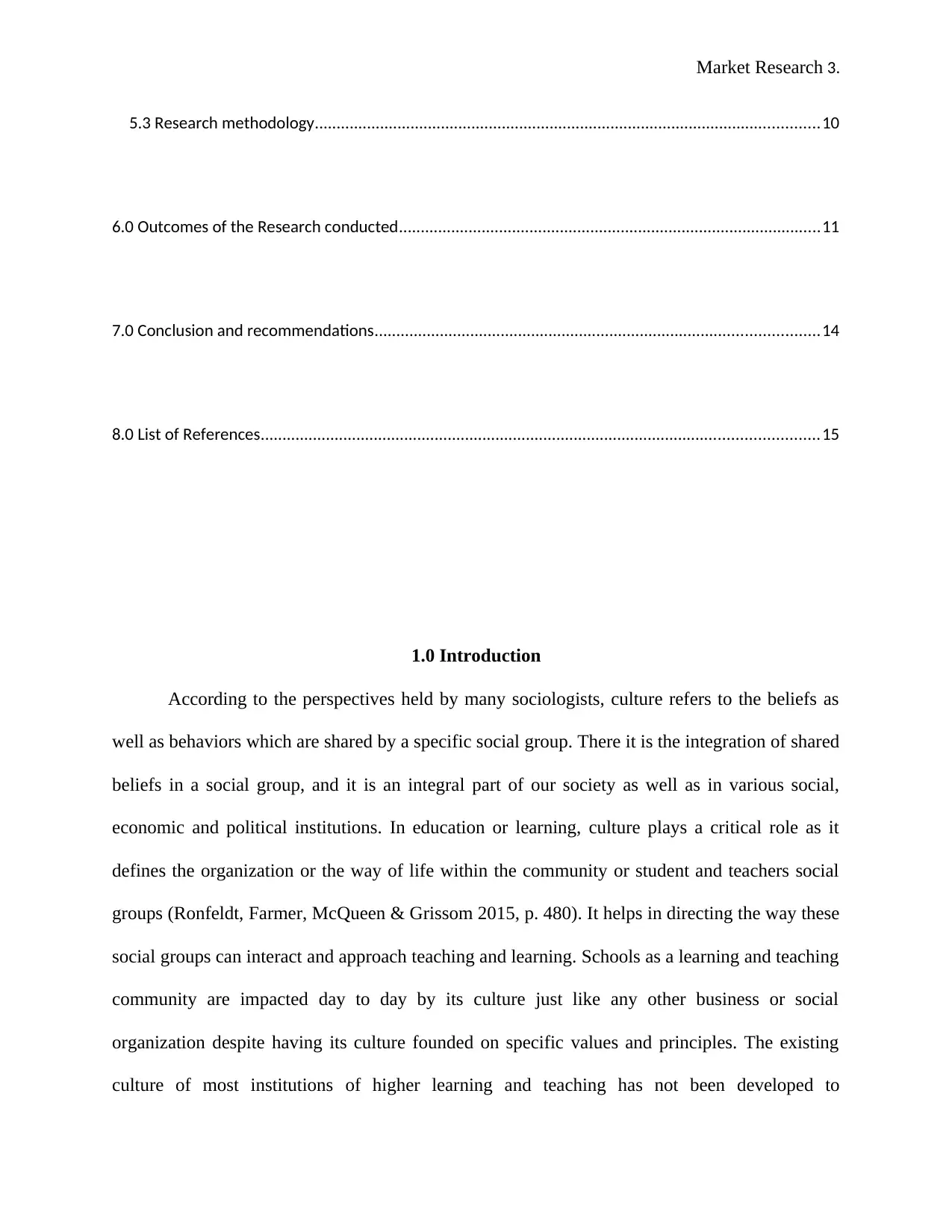
Market Research 3.
5.3 Research methodology....................................................................................................................10
6.0 Outcomes of the Research conducted.................................................................................................11
7.0 Conclusion and recommendations......................................................................................................14
8.0 List of References................................................................................................................................15
1.0 Introduction
According to the perspectives held by many sociologists, culture refers to the beliefs as
well as behaviors which are shared by a specific social group. There it is the integration of shared
beliefs in a social group, and it is an integral part of our society as well as in various social,
economic and political institutions. In education or learning, culture plays a critical role as it
defines the organization or the way of life within the community or student and teachers social
groups (Ronfeldt, Farmer, McQueen & Grissom 2015, p. 480). It helps in directing the way these
social groups can interact and approach teaching and learning. Schools as a learning and teaching
community are impacted day to day by its culture just like any other business or social
organization despite having its culture founded on specific values and principles. The existing
culture of most institutions of higher learning and teaching has not been developed to
5.3 Research methodology....................................................................................................................10
6.0 Outcomes of the Research conducted.................................................................................................11
7.0 Conclusion and recommendations......................................................................................................14
8.0 List of References................................................................................................................................15
1.0 Introduction
According to the perspectives held by many sociologists, culture refers to the beliefs as
well as behaviors which are shared by a specific social group. There it is the integration of shared
beliefs in a social group, and it is an integral part of our society as well as in various social,
economic and political institutions. In education or learning, culture plays a critical role as it
defines the organization or the way of life within the community or student and teachers social
groups (Ronfeldt, Farmer, McQueen & Grissom 2015, p. 480). It helps in directing the way these
social groups can interact and approach teaching and learning. Schools as a learning and teaching
community are impacted day to day by its culture just like any other business or social
organization despite having its culture founded on specific values and principles. The existing
culture of most institutions of higher learning and teaching has not been developed to
⊘ This is a preview!⊘
Do you want full access?
Subscribe today to unlock all pages.

Trusted by 1+ million students worldwide

Market Research 4.
accommodate cultural inclusivity and therefore faces a significant challenge in operating with
ethnically or racially diverse student population (Lewallen, Hunt, Potts‐Datema, Zaza & Giles
2015, p. 732). Therefore there is a need to the various faculties in these institutions to develop an
understanding of cultural diversity through examining the institutions or faculty cultural
background and understanding how their institutional, cultural bias affects their relationships and
interactions with the students.
Developing a culturally responsive learning community requires the understanding of the
cultural beliefs, values and perceptions of students and how they can understand what they hear
or learn what they are taught and their ability to express themselves in the classroom. The
understanding of these different perspectives by teachers plays a critical role in designing various
classroom instructions which will help in connecting student’s backgrounds to the content
(McLeskey, Rosenberg & Westling, 2017, p. 27). Therefore the purpose of this report is to
examine an approach that can be used to build a learning and teaching community through
faculty professional development and collaboration. This will be achieved by focusing on
cultural responsiveness elements through the understanding of the five institutions of religion,
family, school, economics, and politics. The report will offer the findings of the investigation of
individuals as well as institutional backgrounds in the determination of faculty ability to
recognize the various forces or factors that influence student behavior and how to engage the
students in a more active learning process. The findings of the report will be based on a student-
teacher-faculty interactive workshop conducted by the school of business at KDU to develop a
culturally responsive learning community.
accommodate cultural inclusivity and therefore faces a significant challenge in operating with
ethnically or racially diverse student population (Lewallen, Hunt, Potts‐Datema, Zaza & Giles
2015, p. 732). Therefore there is a need to the various faculties in these institutions to develop an
understanding of cultural diversity through examining the institutions or faculty cultural
background and understanding how their institutional, cultural bias affects their relationships and
interactions with the students.
Developing a culturally responsive learning community requires the understanding of the
cultural beliefs, values and perceptions of students and how they can understand what they hear
or learn what they are taught and their ability to express themselves in the classroom. The
understanding of these different perspectives by teachers plays a critical role in designing various
classroom instructions which will help in connecting student’s backgrounds to the content
(McLeskey, Rosenberg & Westling, 2017, p. 27). Therefore the purpose of this report is to
examine an approach that can be used to build a learning and teaching community through
faculty professional development and collaboration. This will be achieved by focusing on
cultural responsiveness elements through the understanding of the five institutions of religion,
family, school, economics, and politics. The report will offer the findings of the investigation of
individuals as well as institutional backgrounds in the determination of faculty ability to
recognize the various forces or factors that influence student behavior and how to engage the
students in a more active learning process. The findings of the report will be based on a student-
teacher-faculty interactive workshop conducted by the school of business at KDU to develop a
culturally responsive learning community.
Paraphrase This Document
Need a fresh take? Get an instant paraphrase of this document with our AI Paraphraser
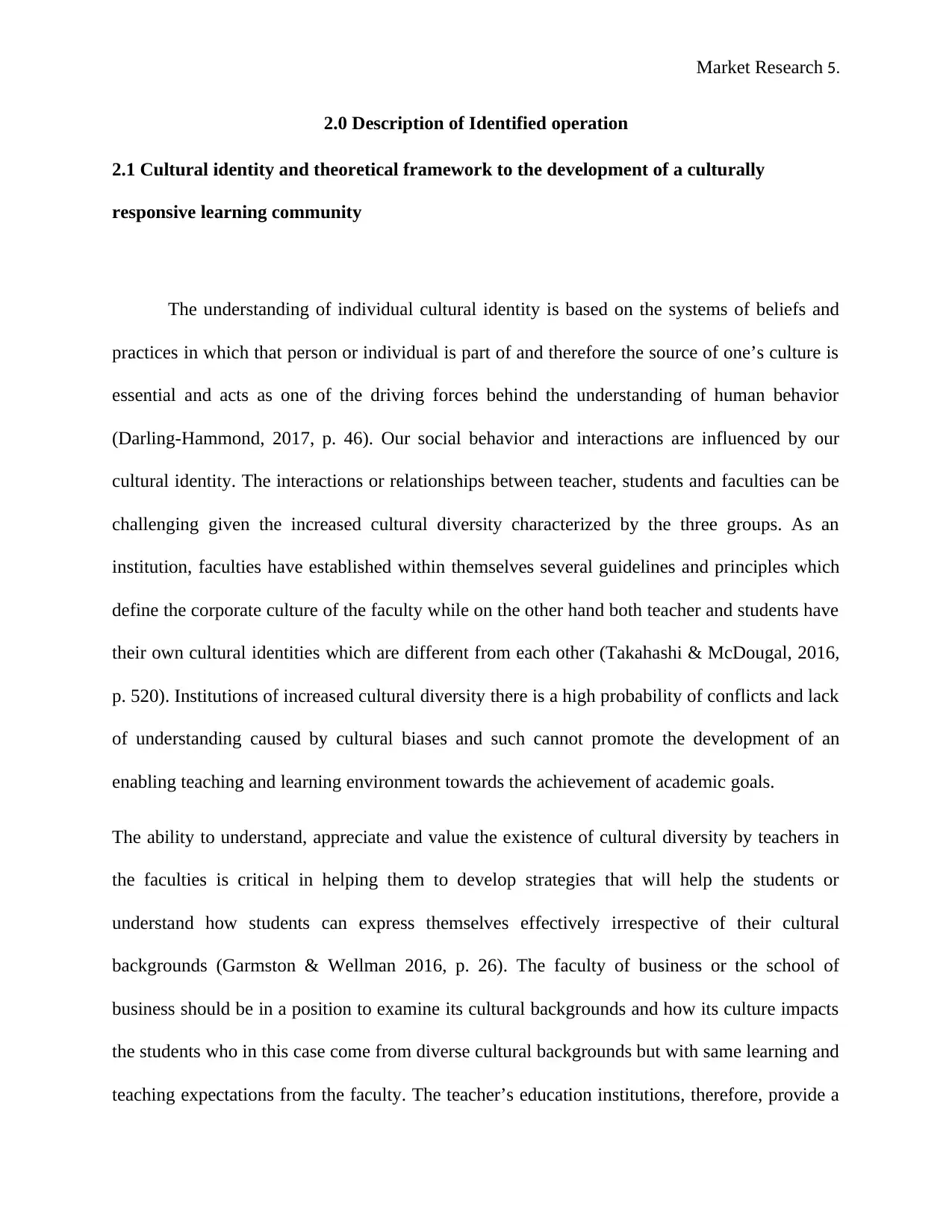
Market Research 5.
2.0 Description of Identified operation
2.1 Cultural identity and theoretical framework to the development of a culturally
responsive learning community
The understanding of individual cultural identity is based on the systems of beliefs and
practices in which that person or individual is part of and therefore the source of one’s culture is
essential and acts as one of the driving forces behind the understanding of human behavior
(Darling-Hammond, 2017, p. 46). Our social behavior and interactions are influenced by our
cultural identity. The interactions or relationships between teacher, students and faculties can be
challenging given the increased cultural diversity characterized by the three groups. As an
institution, faculties have established within themselves several guidelines and principles which
define the corporate culture of the faculty while on the other hand both teacher and students have
their own cultural identities which are different from each other (Takahashi & McDougal, 2016,
p. 520). Institutions of increased cultural diversity there is a high probability of conflicts and lack
of understanding caused by cultural biases and such cannot promote the development of an
enabling teaching and learning environment towards the achievement of academic goals.
The ability to understand, appreciate and value the existence of cultural diversity by teachers in
the faculties is critical in helping them to develop strategies that will help the students or
understand how students can express themselves effectively irrespective of their cultural
backgrounds (Garmston & Wellman 2016, p. 26). The faculty of business or the school of
business should be in a position to examine its cultural backgrounds and how its culture impacts
the students who in this case come from diverse cultural backgrounds but with same learning and
teaching expectations from the faculty. The teacher’s education institutions, therefore, provide a
2.0 Description of Identified operation
2.1 Cultural identity and theoretical framework to the development of a culturally
responsive learning community
The understanding of individual cultural identity is based on the systems of beliefs and
practices in which that person or individual is part of and therefore the source of one’s culture is
essential and acts as one of the driving forces behind the understanding of human behavior
(Darling-Hammond, 2017, p. 46). Our social behavior and interactions are influenced by our
cultural identity. The interactions or relationships between teacher, students and faculties can be
challenging given the increased cultural diversity characterized by the three groups. As an
institution, faculties have established within themselves several guidelines and principles which
define the corporate culture of the faculty while on the other hand both teacher and students have
their own cultural identities which are different from each other (Takahashi & McDougal, 2016,
p. 520). Institutions of increased cultural diversity there is a high probability of conflicts and lack
of understanding caused by cultural biases and such cannot promote the development of an
enabling teaching and learning environment towards the achievement of academic goals.
The ability to understand, appreciate and value the existence of cultural diversity by teachers in
the faculties is critical in helping them to develop strategies that will help the students or
understand how students can express themselves effectively irrespective of their cultural
backgrounds (Garmston & Wellman 2016, p. 26). The faculty of business or the school of
business should be in a position to examine its cultural backgrounds and how its culture impacts
the students who in this case come from diverse cultural backgrounds but with same learning and
teaching expectations from the faculty. The teacher’s education institutions, therefore, provide a

Market Research 6.
useful analysis of how we can develop culturally responsive teachers (Kelly & Cherkowski,
2015, p. 169). Such teachers have a social-cultural consciousness, a clear sense, and perspective
on cultural diversity and recognition of the fact that they have the potential to bring about
changes that will make education and schooling experiences more responsive to a community of
culturally diverse students.
The theoretical development of culturally responsive teachers is, therefore, a function of
the increased cultural diversity in learning institution which influences the student’s behavior and
the ability to express them (Owen 2015, p. 60). Its focus is to develop or create an enabling
teaching and learning environment through cultural responsive behavior teachers, students, and
faculties. However cultural responsiveness is determined by the ability and the willingness of the
affected groups to change their perspectives and especially the racial or ethnic perspectives
which brings about differences in learning and teaching institutions (Khalifa, Gooden & Davis
2016, p. 1276). It, therefore, goes beyond the responsibility of the teachers to develop a culture
of cultural responsiveness to students and institutional changes towards the development of a
culturally inclusive learning community. Socio-cultural consciousness for teachers, students, and
the faculties is the awareness or ability to see and understand that the world is not universal and
therefore it is molded by our life experiences which are influenced by factors such as race,
ethnicity, social class, and gender (Nieto, 2015, p. 8). Therefore the ability to understand an
individual’s perspective on race, ethnicity, gender and social class as a representation of personal
experiences as well as the fact that others may not share these variables, is, therefore, a
prerequisite for effective communication in a multicultural society characterized by increased
cultural diversity. It, therefore, forms the theoretical basis for the development of culturally
responsive learning community which shared values, beliefs, and understanding of their existing
useful analysis of how we can develop culturally responsive teachers (Kelly & Cherkowski,
2015, p. 169). Such teachers have a social-cultural consciousness, a clear sense, and perspective
on cultural diversity and recognition of the fact that they have the potential to bring about
changes that will make education and schooling experiences more responsive to a community of
culturally diverse students.
The theoretical development of culturally responsive teachers is, therefore, a function of
the increased cultural diversity in learning institution which influences the student’s behavior and
the ability to express them (Owen 2015, p. 60). Its focus is to develop or create an enabling
teaching and learning environment through cultural responsive behavior teachers, students, and
faculties. However cultural responsiveness is determined by the ability and the willingness of the
affected groups to change their perspectives and especially the racial or ethnic perspectives
which brings about differences in learning and teaching institutions (Khalifa, Gooden & Davis
2016, p. 1276). It, therefore, goes beyond the responsibility of the teachers to develop a culture
of cultural responsiveness to students and institutional changes towards the development of a
culturally inclusive learning community. Socio-cultural consciousness for teachers, students, and
the faculties is the awareness or ability to see and understand that the world is not universal and
therefore it is molded by our life experiences which are influenced by factors such as race,
ethnicity, social class, and gender (Nieto, 2015, p. 8). Therefore the ability to understand an
individual’s perspective on race, ethnicity, gender and social class as a representation of personal
experiences as well as the fact that others may not share these variables, is, therefore, a
prerequisite for effective communication in a multicultural society characterized by increased
cultural diversity. It, therefore, forms the theoretical basis for the development of culturally
responsive learning community which shared values, beliefs, and understanding of their existing
⊘ This is a preview!⊘
Do you want full access?
Subscribe today to unlock all pages.

Trusted by 1+ million students worldwide

Market Research 7.
differences (Lind & McKoy, 2016, p. 120). The KDU culture is built on the premise that the
more people can understand their own culture the better is their ability to address any issues
arising from their cultural identity while appreciating other cultures. Its school university mission
is, therefore, to empower students from diverse cultures through the integration of educational
knowledge and skills as well as career-focused education (Grant & Ray, 2018, p. 17). It is the
examination of the culture of the institution from time to time based on the mission to determine
the effectiveness of the culture in helping students and teachers achieve their academic
achievement goals.
3.0 Identified Operation for the Research report
To achieve the objective of the research which was to address cultural diversity at classroom by
developing a culturally responsive learning community through teachers, faculty and student
collaboration a five-day workshop was developed about the five critical institutions which affect
or influence student’s behavior and how teachers can effectively engage them. The five critical
institutions include family, school, religion, politics, and economics. The five institutions have a
significant impact on our cultural behavior and may influence student perspectives on other
cultures as well as their ability to respond to various issues resulting from cultural diversity. The
impact of these forces was discussed based on various research questions developed for the
workshop in understanding personal and individual perspectives on cultural diversity. The
workshop was designed to take five days in which every day there were different sessions which
had different tasks and activities designed.
The first session or day of the workshop will involve the grouping of the emerging
cultural issues to be discussed based on the five aspects of family, religion, politics, school, and
politics. The issues will be analyzed based on the developed questions that will help in getting
differences (Lind & McKoy, 2016, p. 120). The KDU culture is built on the premise that the
more people can understand their own culture the better is their ability to address any issues
arising from their cultural identity while appreciating other cultures. Its school university mission
is, therefore, to empower students from diverse cultures through the integration of educational
knowledge and skills as well as career-focused education (Grant & Ray, 2018, p. 17). It is the
examination of the culture of the institution from time to time based on the mission to determine
the effectiveness of the culture in helping students and teachers achieve their academic
achievement goals.
3.0 Identified Operation for the Research report
To achieve the objective of the research which was to address cultural diversity at classroom by
developing a culturally responsive learning community through teachers, faculty and student
collaboration a five-day workshop was developed about the five critical institutions which affect
or influence student’s behavior and how teachers can effectively engage them. The five critical
institutions include family, school, religion, politics, and economics. The five institutions have a
significant impact on our cultural behavior and may influence student perspectives on other
cultures as well as their ability to respond to various issues resulting from cultural diversity. The
impact of these forces was discussed based on various research questions developed for the
workshop in understanding personal and individual perspectives on cultural diversity. The
workshop was designed to take five days in which every day there were different sessions which
had different tasks and activities designed.
The first session or day of the workshop will involve the grouping of the emerging
cultural issues to be discussed based on the five aspects of family, religion, politics, school, and
politics. The issues will be analyzed based on the developed questions that will help in getting
Paraphrase This Document
Need a fresh take? Get an instant paraphrase of this document with our AI Paraphraser
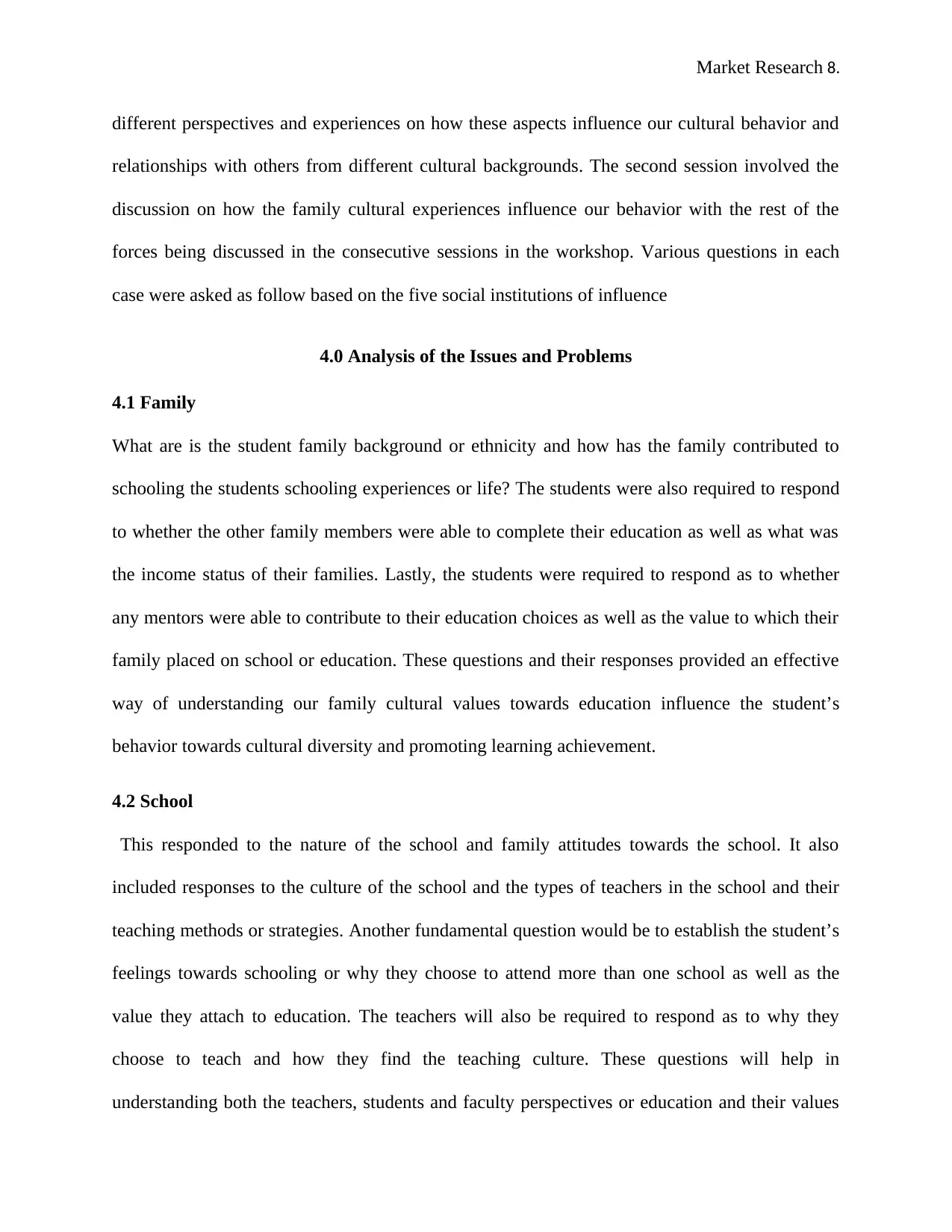
Market Research 8.
different perspectives and experiences on how these aspects influence our cultural behavior and
relationships with others from different cultural backgrounds. The second session involved the
discussion on how the family cultural experiences influence our behavior with the rest of the
forces being discussed in the consecutive sessions in the workshop. Various questions in each
case were asked as follow based on the five social institutions of influence
4.0 Analysis of the Issues and Problems
4.1 Family
What are is the student family background or ethnicity and how has the family contributed to
schooling the students schooling experiences or life? The students were also required to respond
to whether the other family members were able to complete their education as well as what was
the income status of their families. Lastly, the students were required to respond as to whether
any mentors were able to contribute to their education choices as well as the value to which their
family placed on school or education. These questions and their responses provided an effective
way of understanding our family cultural values towards education influence the student’s
behavior towards cultural diversity and promoting learning achievement.
4.2 School
This responded to the nature of the school and family attitudes towards the school. It also
included responses to the culture of the school and the types of teachers in the school and their
teaching methods or strategies. Another fundamental question would be to establish the student’s
feelings towards schooling or why they choose to attend more than one school as well as the
value they attach to education. The teachers will also be required to respond as to why they
choose to teach and how they find the teaching culture. These questions will help in
understanding both the teachers, students and faculty perspectives or education and their values
different perspectives and experiences on how these aspects influence our cultural behavior and
relationships with others from different cultural backgrounds. The second session involved the
discussion on how the family cultural experiences influence our behavior with the rest of the
forces being discussed in the consecutive sessions in the workshop. Various questions in each
case were asked as follow based on the five social institutions of influence
4.0 Analysis of the Issues and Problems
4.1 Family
What are is the student family background or ethnicity and how has the family contributed to
schooling the students schooling experiences or life? The students were also required to respond
to whether the other family members were able to complete their education as well as what was
the income status of their families. Lastly, the students were required to respond as to whether
any mentors were able to contribute to their education choices as well as the value to which their
family placed on school or education. These questions and their responses provided an effective
way of understanding our family cultural values towards education influence the student’s
behavior towards cultural diversity and promoting learning achievement.
4.2 School
This responded to the nature of the school and family attitudes towards the school. It also
included responses to the culture of the school and the types of teachers in the school and their
teaching methods or strategies. Another fundamental question would be to establish the student’s
feelings towards schooling or why they choose to attend more than one school as well as the
value they attach to education. The teachers will also be required to respond as to why they
choose to teach and how they find the teaching culture. These questions will help in
understanding both the teachers, students and faculty perspectives or education and their values
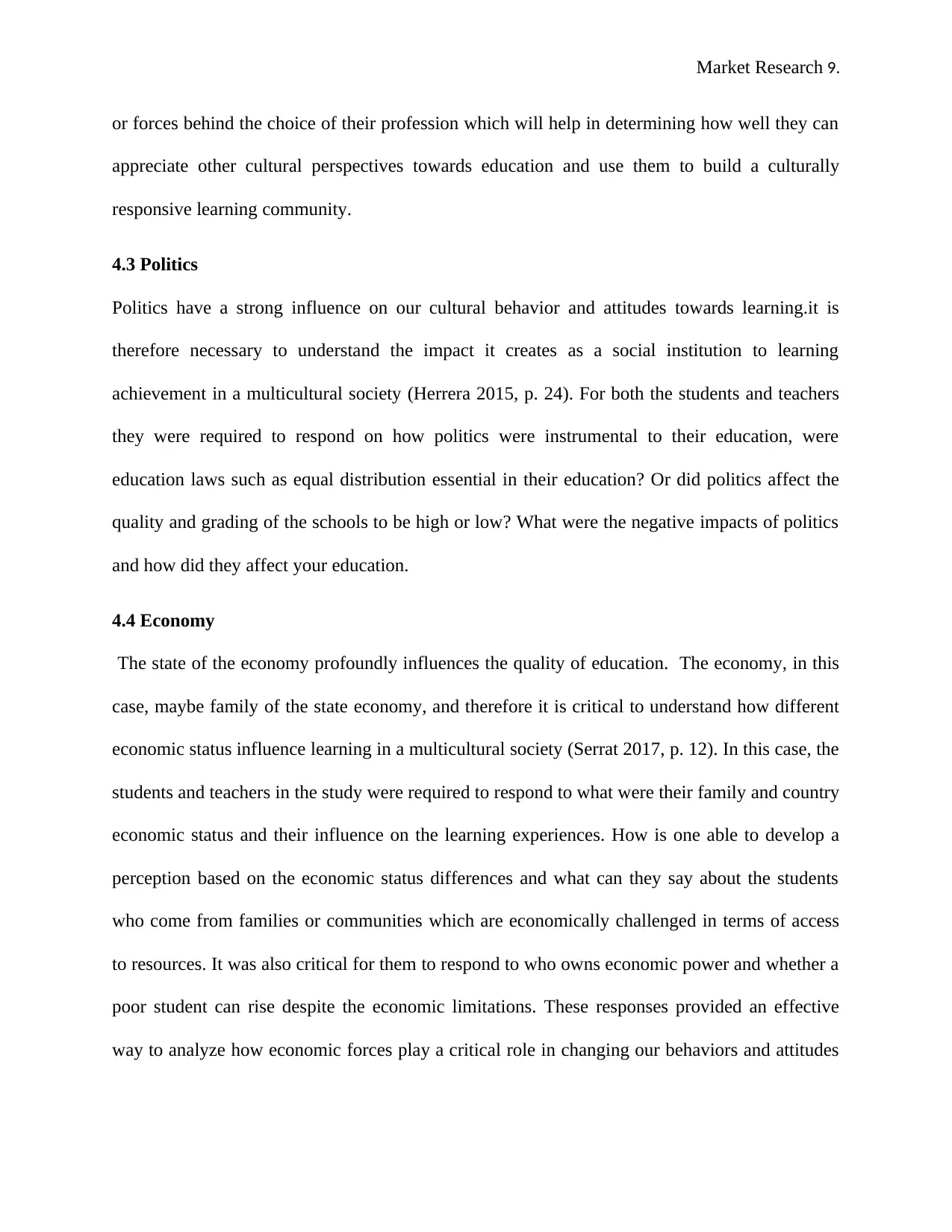
Market Research 9.
or forces behind the choice of their profession which will help in determining how well they can
appreciate other cultural perspectives towards education and use them to build a culturally
responsive learning community.
4.3 Politics
Politics have a strong influence on our cultural behavior and attitudes towards learning.it is
therefore necessary to understand the impact it creates as a social institution to learning
achievement in a multicultural society (Herrera 2015, p. 24). For both the students and teachers
they were required to respond on how politics were instrumental to their education, were
education laws such as equal distribution essential in their education? Or did politics affect the
quality and grading of the schools to be high or low? What were the negative impacts of politics
and how did they affect your education.
4.4 Economy
The state of the economy profoundly influences the quality of education. The economy, in this
case, maybe family of the state economy, and therefore it is critical to understand how different
economic status influence learning in a multicultural society (Serrat 2017, p. 12). In this case, the
students and teachers in the study were required to respond to what were their family and country
economic status and their influence on the learning experiences. How is one able to develop a
perception based on the economic status differences and what can they say about the students
who come from families or communities which are economically challenged in terms of access
to resources. It was also critical for them to respond to who owns economic power and whether a
poor student can rise despite the economic limitations. These responses provided an effective
way to analyze how economic forces play a critical role in changing our behaviors and attitudes
or forces behind the choice of their profession which will help in determining how well they can
appreciate other cultural perspectives towards education and use them to build a culturally
responsive learning community.
4.3 Politics
Politics have a strong influence on our cultural behavior and attitudes towards learning.it is
therefore necessary to understand the impact it creates as a social institution to learning
achievement in a multicultural society (Herrera 2015, p. 24). For both the students and teachers
they were required to respond on how politics were instrumental to their education, were
education laws such as equal distribution essential in their education? Or did politics affect the
quality and grading of the schools to be high or low? What were the negative impacts of politics
and how did they affect your education.
4.4 Economy
The state of the economy profoundly influences the quality of education. The economy, in this
case, maybe family of the state economy, and therefore it is critical to understand how different
economic status influence learning in a multicultural society (Serrat 2017, p. 12). In this case, the
students and teachers in the study were required to respond to what were their family and country
economic status and their influence on the learning experiences. How is one able to develop a
perception based on the economic status differences and what can they say about the students
who come from families or communities which are economically challenged in terms of access
to resources. It was also critical for them to respond to who owns economic power and whether a
poor student can rise despite the economic limitations. These responses provided an effective
way to analyze how economic forces play a critical role in changing our behaviors and attitudes
⊘ This is a preview!⊘
Do you want full access?
Subscribe today to unlock all pages.

Trusted by 1+ million students worldwide
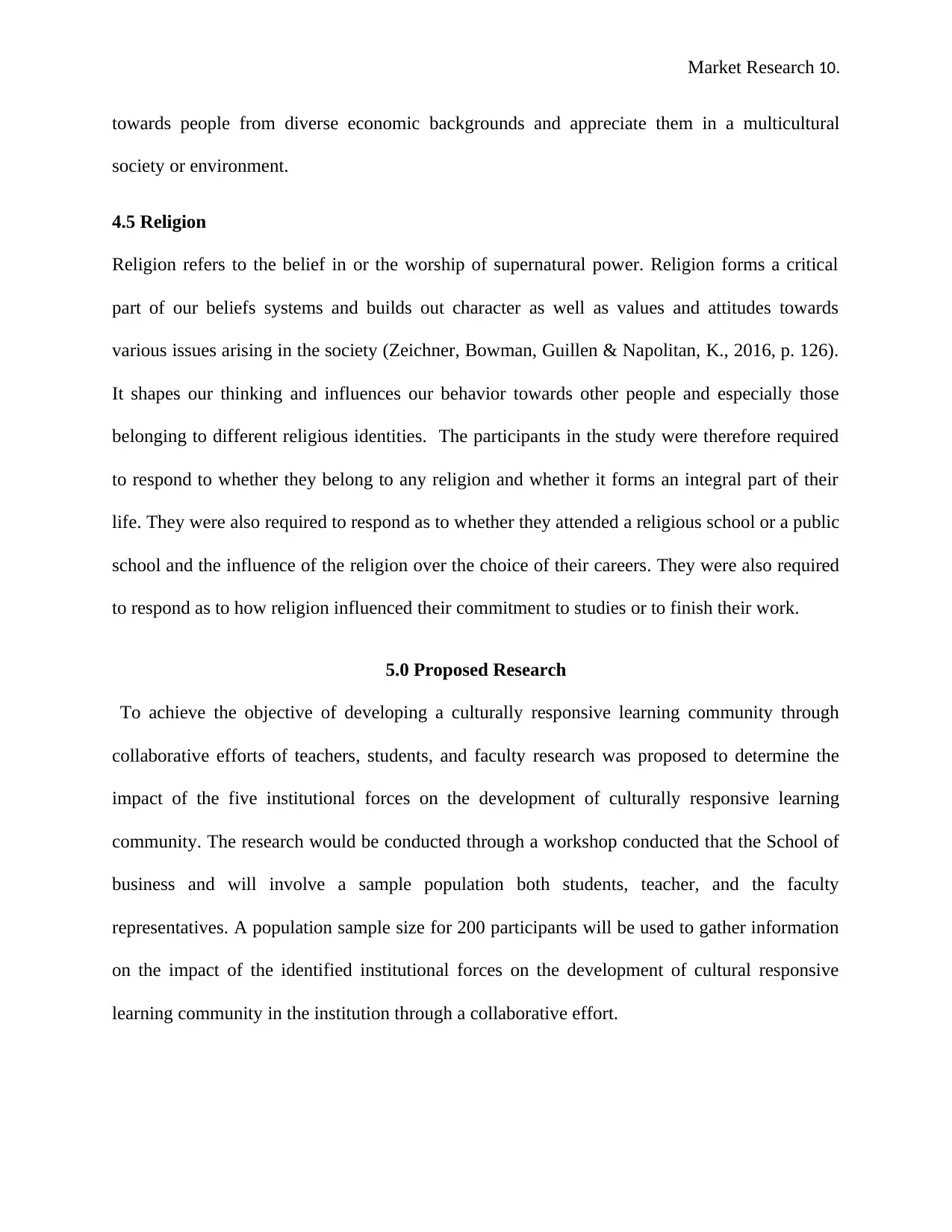
Market Research 10.
towards people from diverse economic backgrounds and appreciate them in a multicultural
society or environment.
4.5 Religion
Religion refers to the belief in or the worship of supernatural power. Religion forms a critical
part of our beliefs systems and builds out character as well as values and attitudes towards
various issues arising in the society (Zeichner, Bowman, Guillen & Napolitan, K., 2016, p. 126).
It shapes our thinking and influences our behavior towards other people and especially those
belonging to different religious identities. The participants in the study were therefore required
to respond to whether they belong to any religion and whether it forms an integral part of their
life. They were also required to respond as to whether they attended a religious school or a public
school and the influence of the religion over the choice of their careers. They were also required
to respond as to how religion influenced their commitment to studies or to finish their work.
5.0 Proposed Research
To achieve the objective of developing a culturally responsive learning community through
collaborative efforts of teachers, students, and faculty research was proposed to determine the
impact of the five institutional forces on the development of culturally responsive learning
community. The research would be conducted through a workshop conducted that the School of
business and will involve a sample population both students, teacher, and the faculty
representatives. A population sample size for 200 participants will be used to gather information
on the impact of the identified institutional forces on the development of cultural responsive
learning community in the institution through a collaborative effort.
towards people from diverse economic backgrounds and appreciate them in a multicultural
society or environment.
4.5 Religion
Religion refers to the belief in or the worship of supernatural power. Religion forms a critical
part of our beliefs systems and builds out character as well as values and attitudes towards
various issues arising in the society (Zeichner, Bowman, Guillen & Napolitan, K., 2016, p. 126).
It shapes our thinking and influences our behavior towards other people and especially those
belonging to different religious identities. The participants in the study were therefore required
to respond to whether they belong to any religion and whether it forms an integral part of their
life. They were also required to respond as to whether they attended a religious school or a public
school and the influence of the religion over the choice of their careers. They were also required
to respond as to how religion influenced their commitment to studies or to finish their work.
5.0 Proposed Research
To achieve the objective of developing a culturally responsive learning community through
collaborative efforts of teachers, students, and faculty research was proposed to determine the
impact of the five institutional forces on the development of culturally responsive learning
community. The research would be conducted through a workshop conducted that the School of
business and will involve a sample population both students, teacher, and the faculty
representatives. A population sample size for 200 participants will be used to gather information
on the impact of the identified institutional forces on the development of cultural responsive
learning community in the institution through a collaborative effort.
Paraphrase This Document
Need a fresh take? Get an instant paraphrase of this document with our AI Paraphraser

Market Research 11.
5.1 Research objective
To determine the impact of religious, family, school, political and economic institutions
on the development of culturally responsive learning community.
5.2 Research Questions
How does family institution impact our perspectives and beliefs on cultural diversity and
its influence on learning?
What is the impact of religion on learning in a multicultural society?
Does the political climate of a country impact on learning experiences in a multicultural
society
What is the contribution of school culture towards the development of a culturally
responsive learning community?
How do economic conditions and status impact the development of culturally responsive
learning communities?
5.3 Research methodology
The research will be conducted through focused group discussion as organized in the workshop.
The research will utilize the use of a questionnaire to collect information through discussion
from the focused group discussions. The information discussed will then be evaluated and
analyzed through a comparative analysis with other information from the rest of the groups. The
findings of the research will then be presented to each group inform of a report.
6.0 Outcomes of the Research conducted
Based on the findings of the workshop conducted for the five days at the KDU University as
organized by the school of business, different issues were identified which the participants
5.1 Research objective
To determine the impact of religious, family, school, political and economic institutions
on the development of culturally responsive learning community.
5.2 Research Questions
How does family institution impact our perspectives and beliefs on cultural diversity and
its influence on learning?
What is the impact of religion on learning in a multicultural society?
Does the political climate of a country impact on learning experiences in a multicultural
society
What is the contribution of school culture towards the development of a culturally
responsive learning community?
How do economic conditions and status impact the development of culturally responsive
learning communities?
5.3 Research methodology
The research will be conducted through focused group discussion as organized in the workshop.
The research will utilize the use of a questionnaire to collect information through discussion
from the focused group discussions. The information discussed will then be evaluated and
analyzed through a comparative analysis with other information from the rest of the groups. The
findings of the research will then be presented to each group inform of a report.
6.0 Outcomes of the Research conducted
Based on the findings of the workshop conducted for the five days at the KDU University as
organized by the school of business, different issues were identified which the participants
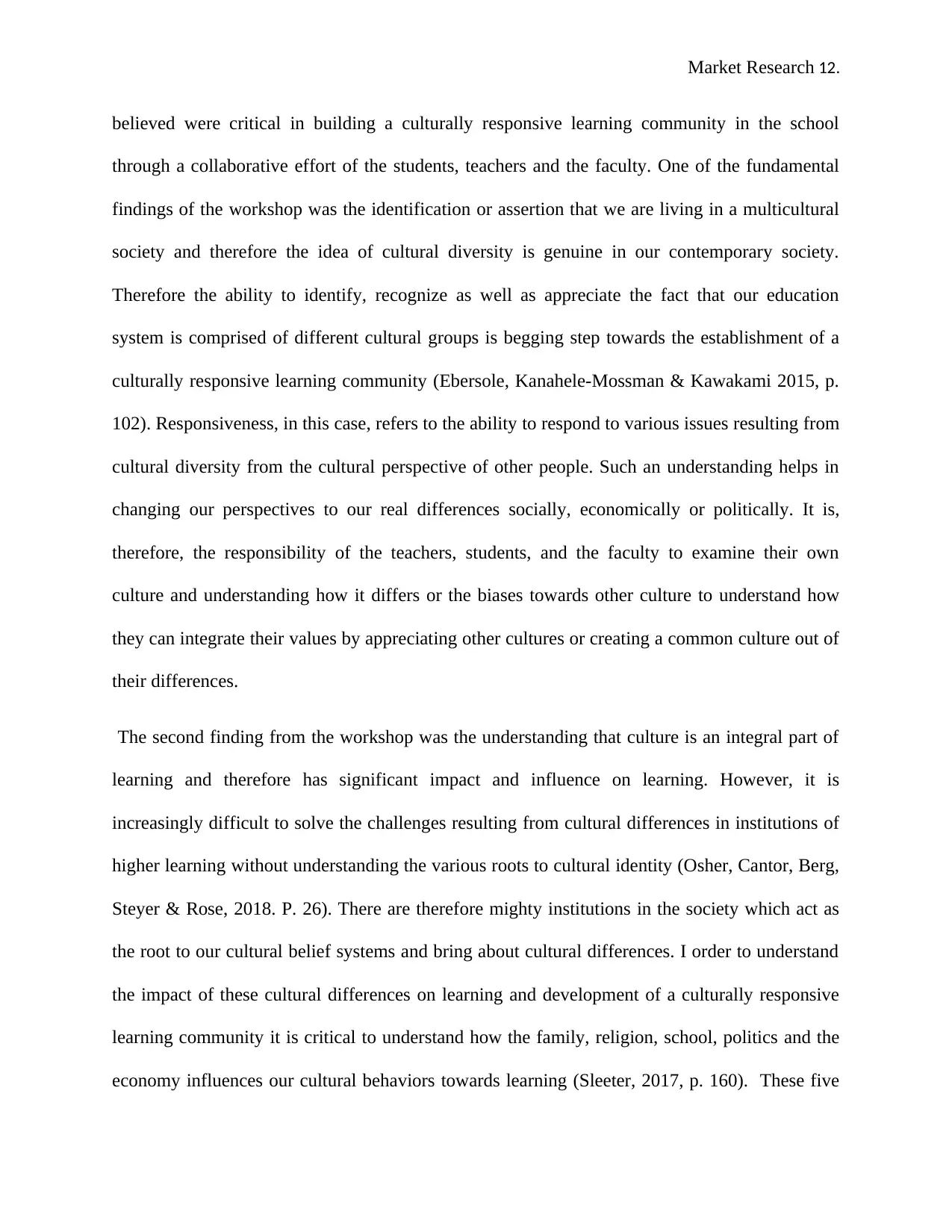
Market Research 12.
believed were critical in building a culturally responsive learning community in the school
through a collaborative effort of the students, teachers and the faculty. One of the fundamental
findings of the workshop was the identification or assertion that we are living in a multicultural
society and therefore the idea of cultural diversity is genuine in our contemporary society.
Therefore the ability to identify, recognize as well as appreciate the fact that our education
system is comprised of different cultural groups is begging step towards the establishment of a
culturally responsive learning community (Ebersole, Kanahele-Mossman & Kawakami 2015, p.
102). Responsiveness, in this case, refers to the ability to respond to various issues resulting from
cultural diversity from the cultural perspective of other people. Such an understanding helps in
changing our perspectives to our real differences socially, economically or politically. It is,
therefore, the responsibility of the teachers, students, and the faculty to examine their own
culture and understanding how it differs or the biases towards other culture to understand how
they can integrate their values by appreciating other cultures or creating a common culture out of
their differences.
The second finding from the workshop was the understanding that culture is an integral part of
learning and therefore has significant impact and influence on learning. However, it is
increasingly difficult to solve the challenges resulting from cultural differences in institutions of
higher learning without understanding the various roots to cultural identity (Osher, Cantor, Berg,
Steyer & Rose, 2018. P. 26). There are therefore mighty institutions in the society which act as
the root to our cultural belief systems and bring about cultural differences. I order to understand
the impact of these cultural differences on learning and development of a culturally responsive
learning community it is critical to understand how the family, religion, school, politics and the
economy influences our cultural behaviors towards learning (Sleeter, 2017, p. 160). These five
believed were critical in building a culturally responsive learning community in the school
through a collaborative effort of the students, teachers and the faculty. One of the fundamental
findings of the workshop was the identification or assertion that we are living in a multicultural
society and therefore the idea of cultural diversity is genuine in our contemporary society.
Therefore the ability to identify, recognize as well as appreciate the fact that our education
system is comprised of different cultural groups is begging step towards the establishment of a
culturally responsive learning community (Ebersole, Kanahele-Mossman & Kawakami 2015, p.
102). Responsiveness, in this case, refers to the ability to respond to various issues resulting from
cultural diversity from the cultural perspective of other people. Such an understanding helps in
changing our perspectives to our real differences socially, economically or politically. It is,
therefore, the responsibility of the teachers, students, and the faculty to examine their own
culture and understanding how it differs or the biases towards other culture to understand how
they can integrate their values by appreciating other cultures or creating a common culture out of
their differences.
The second finding from the workshop was the understanding that culture is an integral part of
learning and therefore has significant impact and influence on learning. However, it is
increasingly difficult to solve the challenges resulting from cultural differences in institutions of
higher learning without understanding the various roots to cultural identity (Osher, Cantor, Berg,
Steyer & Rose, 2018. P. 26). There are therefore mighty institutions in the society which act as
the root to our cultural belief systems and bring about cultural differences. I order to understand
the impact of these cultural differences on learning and development of a culturally responsive
learning community it is critical to understand how the family, religion, school, politics and the
economy influences our cultural behaviors towards learning (Sleeter, 2017, p. 160). These five
⊘ This is a preview!⊘
Do you want full access?
Subscribe today to unlock all pages.

Trusted by 1+ million students worldwide
1 out of 19
Related Documents
Your All-in-One AI-Powered Toolkit for Academic Success.
+13062052269
info@desklib.com
Available 24*7 on WhatsApp / Email
![[object Object]](/_next/static/media/star-bottom.7253800d.svg)
Unlock your academic potential
Copyright © 2020–2025 A2Z Services. All Rights Reserved. Developed and managed by ZUCOL.





